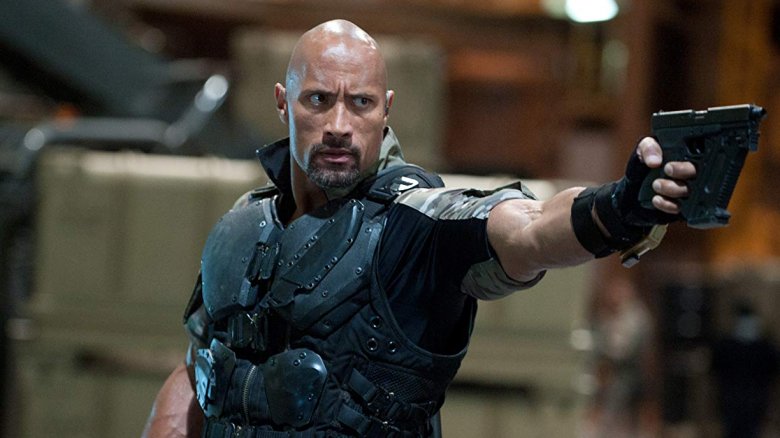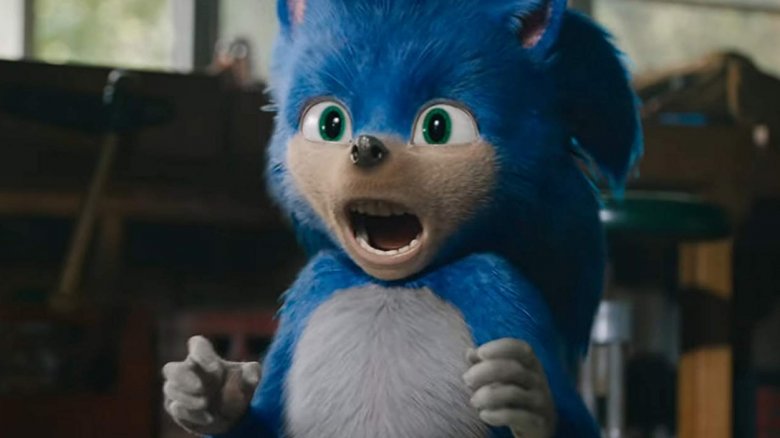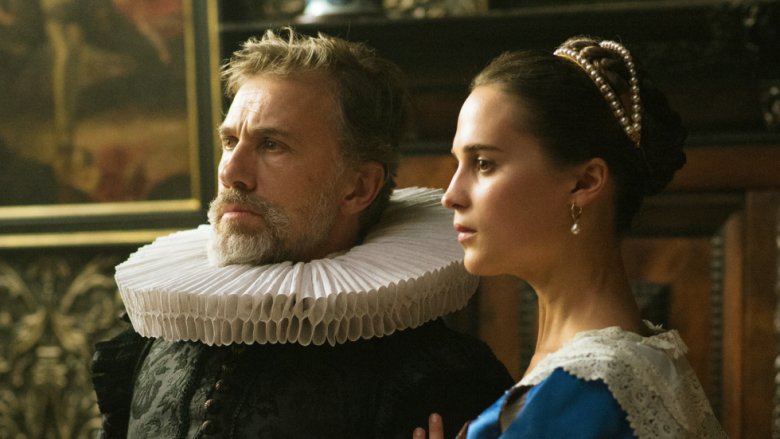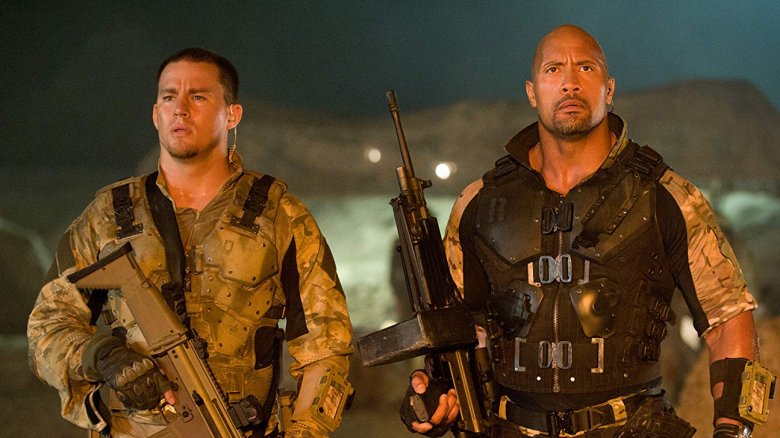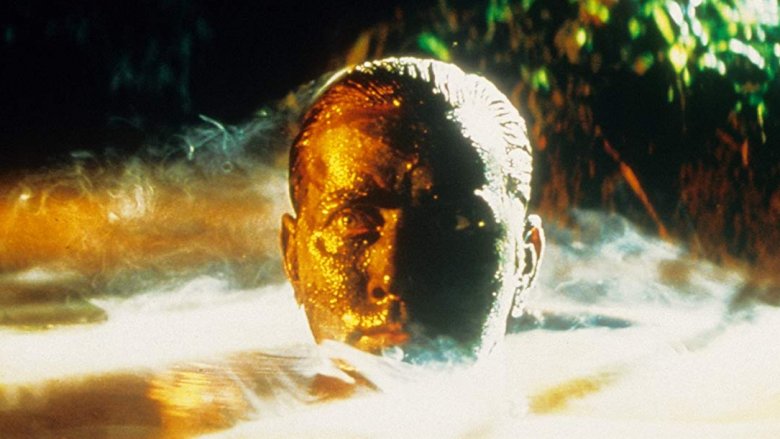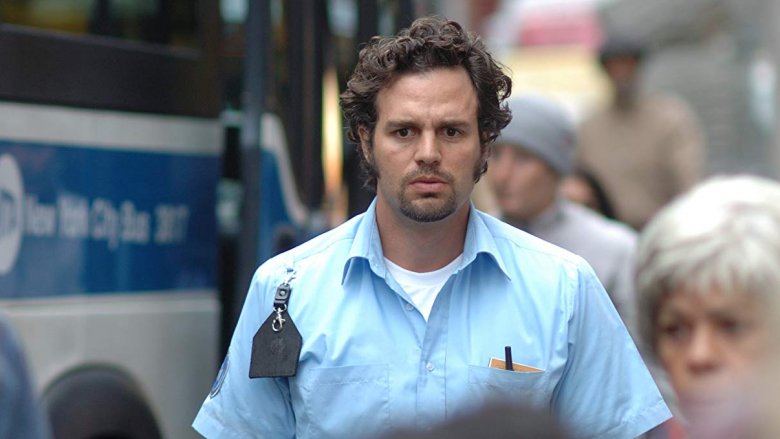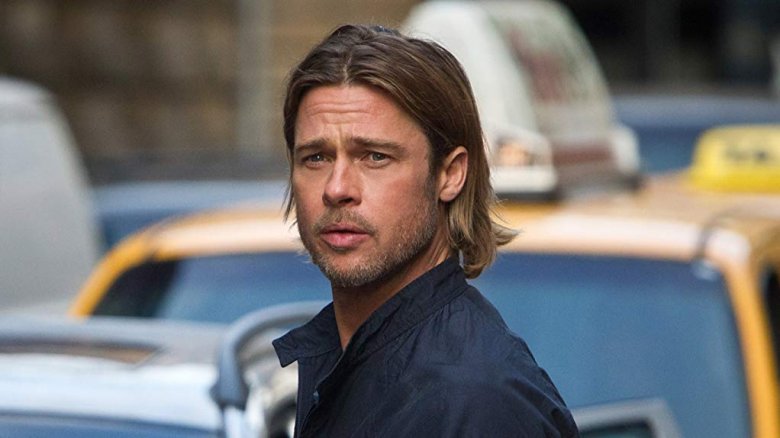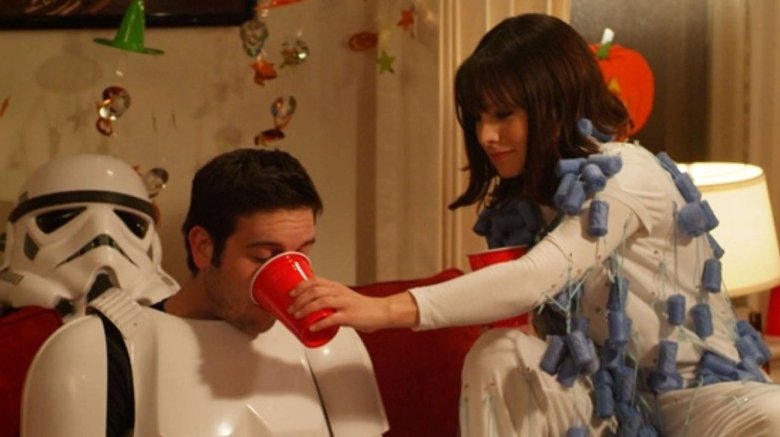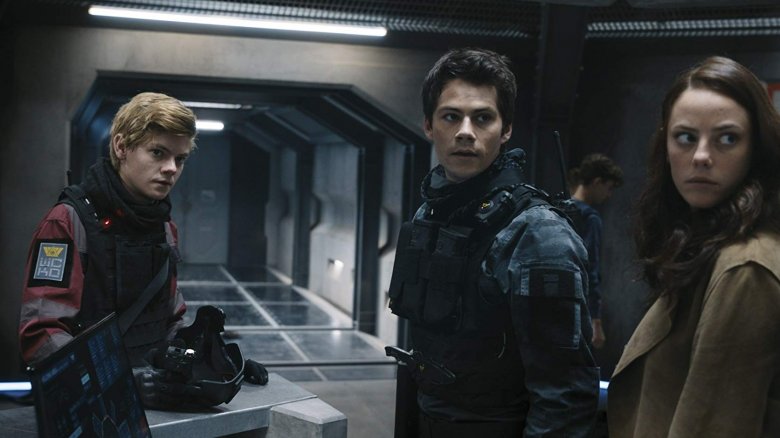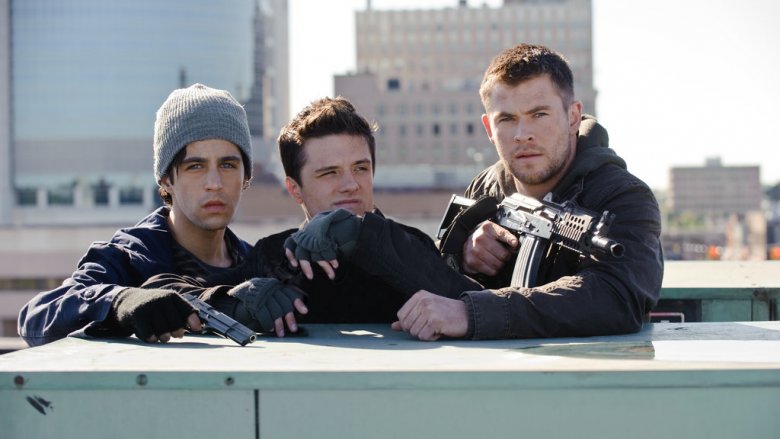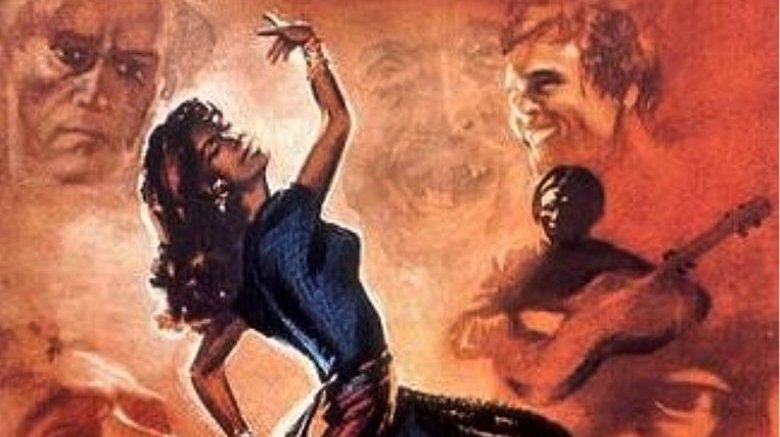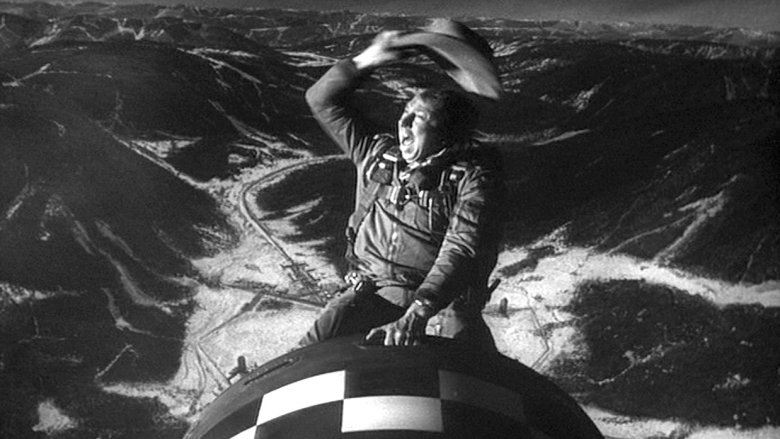The Strangest Reasons Why Movie Productions Were Halted
Movie productions start and stop all the time. Perhaps contract negotiations need to get sussed out, maybe a problematic actor or director has to be dealt with, or perhaps budgetary issues have to be addressed. Sometimes these delays indicate that the quality of a film is being taken seriously. Other times, these delays can just reinforce what we already know about a doomed production. Either way, the movie isn't going anywhere.
Of course, not every film is delayed for mundane reasons. As you might expect, with all the big egos and enormous Hollywood budgets, truly bizarre production delays can rear their ugly heads from time to time, screwing up the shooting schedule and bringing productions to a screeching halt. While these setbacks might be upsetting for fans and filmmakers alike, they do provide some truly insane stories. From animated abominations to political turmoil, these are the strangest reasons why movie productions have been halted.
Sonic the Hedgehog's teeth were a big problem
Poor, poor Sonic the Hedgehog. The trailer reveal was supposed to be the blue blur's big moment. There was a big budget, studio support, and a strong cast to help bring the movie together. Instead, we got a series of bizarre design choices and a seriously misguided sense of humor. The internet was quick to turn against the film, and then something truly bizarre happened.
The studio ... listened?
The backlash was so swift and severe that the studio put the film on hold to "fix" Sonic's design. Honestly, it was the right move. The creature we saw in the movie trailer was most certainly not the same Sonic that became a global video game icon, and quite a few glaring design problems crop up in the trailer. Sonic's weirdly human legs and teeth come to mind immediately.
In fact, after the trailer was released, Sonic's original creator, Naoto Ohshima, chimed in on Twitter, "So far, various Sonics have appeared. I loved all Sonics. I saw a trailer of Sonic's movie. I was expecting adults to have fun too. I am worried."
Welp, that ain't good!
Production on Tulip Fever was delayed due to ... flowers?
The story of Tulip Fever is a classic movie release nightmare. Despite Oscar hopes and a cast of amazing actors, something about the film just never clicked. Its release was delayed repeatedly, but even its production seems cursed, and it's rather ironic that a film about "tulip mania" during the 1600s would see all its critical and box office hopes just wither and die.
The film focuses on a Dutch couple that wagers their money on the sudden interest in tulips. Obviously, the film would need a lot of flowers to be believable, and Deborah Moggach, who wrote the source novel, elaborated on what happened to The Guardian. As she explained, "[The filmmakers] sunk the tank to make the canals, and they'd planted 12,000 tulip bulbs in little pots. Then five hours before the money was locked off and safe, the government closed this tax loophole without any warning, and completely destroyed our movie."
Vulture writes that those thousands of tulips were left to wither and die as the filmmakers scrambled to recover their budget, and Tulip Fever was eventually shot and screened to lackluster returns.
G.I. Joe: Retaliation had a likability problem
G.I. Joe: The Rise of Cobra was certainly nothing to shout about, but the film did a solid job of setting the table for a new franchise, and it made quite a bit of cash during its box office run. A sequel was practically guaranteed. Unfortunately, that sequel was G.I. Joe: Retaliation, which suffered numerous delays and setbacks before limping to the finish line. So what was the main problem? Well, the filmmakers forgot to include likable characters.
The film was delayed almost a year after it screened to test audiences, reportedly to convert the film to 3D. But Deadline scooped the real story: The only thing audiences liked in G.I. Joe: Retaliation was Channing Tatum ... and he died in the first few minutes.
Tatum was the star of the first G.I. Joe film, before roles in movies like 21 Jump Street and Magic Mike propelled him to superstardom. Killing him off may have worked for the story, but audiences hated seeing the charming character axed. So his role was beefed up, but it wasn't quite enough to make a difference when the film was released the next year.
Apocalypse Now was an absolute nightmare to make
While it's widely regarded as a classic, Apocalypse Now seems like it was a doomed production when you see all the problems they faced during the shoot.
Apocalypse Now seems like a doomed production when you start to see all the problems they faced during shooting, but it's still widely regarded as a classic.
First, Harvey Keitel was fired two weeks into shooting by filmmaker Francis Ford Coppola. Martin Sheen was brought in to replace him, but he would later have a heart attack due to stressful conditions and his battle with alcoholism. Coppola blamed himself for Sheen's health issues, and then had an epilectic seizure because of it.
We're just getting started.
Marlon Brando arrived on set weighing over 300 pounds — hardly the feral former Green Beret his Colonel Kurtz was supposed to be. He also hadn't bothered to learn his lines and refused to read the screenplay. As a result, production was halted for a week so Coppola could read the script aloud to Brando and go over his character with him. Of course, the movie ended up being absolutely awesome, so it seems the extra time was well worth it.
Margaret was halted because of its insane runtime
Directors can be finicky about their projects, refusing to bow to studio pressure over various things. For example, take Margaret, the indie drama starring Anna Paquin and directed by Kenneth Lonergan. Despite massive buzz, a great cast, and some all-star producers, Lonergan took years to create an edit he felt comfortable releasing, reportedly because he refused to cut the film to a runtime under three hours.
Margaret actually wrapped shooting in 2005 and was scheduled to release that year, but the studio's (perfectly reasonable) request that the film clock in under two and a half hours was a point of contention. Five years later, Fox Searchlight took Lonergan to court due to his inability to deliver a satisfactory cut of the film.
Multiple people stepped in to work with Lonergan to cut the film, but it still took years (and a loan from his friend, Matthew Broderick) before he would eventually release a version of the film that satisfied both himself and the studio. Margaret was finally released in 2011, but only to a few theaters, and it earned just $46 thousand dollars, missing its $14 million budget by ... well ... about $14 million.
World War Z was raided by the cops
Okay, so picture this scene: Hungarian police get a hot tip that there's a warehouse full of machine guns being stored near their capital's airport. Is it some sort of terrorist cache? A militia stockpile?
Nope, it was just prop storage for World War Z. And they were totally real machine guns.
Brad Pitt's adaptation of the Max Brooks novel was already running over budget and behind schedule, so when the SWAT team swooped in to confiscate the weapons, it put even more stress on things. According to Us Weekly, the main problem is that the weapons came with paperwork stating they were not functional — a fact that was wrong. The guns were completely operational, meaning the production actually shipped in a huge supply of armaments into a major metropolitan area.
To ship in that type of material, the film's production company would've needed to clear it with the Hungary's anti-terrorist unit, something they failed to do. Pitt himself was not to blame for the problem, but it did cause yet another strange delay in an already taxing production.
Fanboys was held back because the studio hated the plot
Before Steven Spielberg brought Ready Player One to life, writer Ernest Cline gave us Fanboys, an impressively heart-filled comedy about a group of friends who want to see The Phantom Menace. It isn't as simple as all that, however, as one of the friends is dying of cancer, and won't make it until the film's release date. So they decide to break into Skywalker Ranch and steal a copy of the film so he can watch it before his disease catches up with him.
The whole "cancer" part is pretty integral to the story. It's too bad the producers didn't get that memo, as they wanted to ax the entire thing.
As it turns out, Harvey Weinstein apparently kept trying to cut the "cancer subplot." In an interview with Thrillist, the filmmakers discuss how the studio kept delaying the film by ignoring the entire plot of the film, saying things like, "Somebody told Harvey that every time cancer came up, the movie was no longer funny." Eventually, the notorious producer "gutted the whole dramatic storyline" where the character is dying. Luckily, buzz for the movie was strong enough (and George Lucas himself gave it the go-ahead) that the filmmakers eventually got to release the version they wanted. It just took a while.
Maze Runner: The Death Cure nearly killed its star
During the craze of YA film adaptation, Hollywood decided to make a Maze Runner series, based on the novels by James Dashner. The awkwardly named Maze Runner: The Death Cure was the third and final film in the trilogy, but unfortunately, the film's production was halted due to a stunt gone wrong, and star Dylan O'Brien nearly lost his life because of it.
In March 2016, O'Brien was filming a stunt where his character was pulled out of a moving vehicle. Tragically, he was struck by another vehicle, fracturing bones in his face and leaving him with severe brain trauma. Filming was postponed and scheduled to begin again in May, but production was shut down indefinitely when it became apparent that the injuries were even more severe than originally thought.
O'Brien almost considered leaving the acting profession altogether while recovering, but he eventually did return to finish The Death Cure and work on other projects.
Production on Red Dawn was halted because of politics
Red Dawn was an odd choice to receive the remake treatment, as the original film is a perfect encapsulation of what the '80s were all about. Updating it for a 2012 audience seemed like a recipe for disaster. However, remake it they did, and studio executives had to delay things a bit during post-production to ensure they could make back as much money as possible.
In the original Red Dawn, a group of schoolboys takes to the woods to fight off an invading Russian force — fitting, considering the political climate in the early '80s. The remake was supposed to feature China as the big bad, but MGM was worried that making China an evil force would jeopardize box office revenue in that very country, putting millions at stake. What could they possibly do?
Obviously, they could digitally change all the Chinese references and symbols to North Korean ones, and hope that American audiences couldn't tell the difference between Chinese and Korean soldiers. Even with the delays to transpose North Korean imagery into the film, it still struggled to make its budget back, proving that some movies just shouldn't be remade.
Tiefland was delayed thanks to the Third Reich
Why'd it have to be Nazis? Tiefland still holds the Guinness World Record for "Longest Live-Action Film Production." Based on an opera, the script for Tiefland was finished in 1934 by Leni Riefenstahl, but production had to be put on hold. Why? Because Hitler wanted Riefenstahl to make Nazi propaganda.
According to MTV, Riefenstahl sat on the script for years as she made Nazi propaganda films, and she was plagued by even more problems once shooting began. In 1944, after the movie was shot and ready to be edited, she was arrested by the American military and interrogated as a possible spy. After she was let go, she was arrested again, this time by the French. They confiscated all of Riefenstahl's property, including the unedited footage for Tiefland.
After release from French arrest, Riefenstahl finished her film. She also starred in the movie, which mean the 50-year-old had to edit footage featuring herself 18 years prior. Due to her close work with Hitler, Riefenstahl's film never found much interest and quietly faded away.
Dr. Strangelove was halted because of the JFK assassination
A lot of movies see slight production delays due to similarities with real world events, but few have had the absolutely dreadful timing of Stanley Kubrick's Dr. Strangelove or: How I Learned to Stop Worrying and Love the Bomb. The film was totally finished and ready to premiere for press reviews, and Kubrick chose the date November 22, 1963 to debut his latest.
If that date doesn't sound familiar, go ahead and Google it. We'll wait.
Hours before the film's premiere, news rolled in that President John F. Kennedy had been shot. He died from his injuries not long after. Kubrick cancelled the premiere immediately, and it didn't take long for him to realize that he'd have to make a few changes to his film.
Most notably, Kubrick cut or changed a few lines that he deemed insensitive (such as, "Our gallant young president has just been struck down in his prime!") before ultimately releasing the film a few months later. Despite the delay, it has gone down as one of Kubrick's best.
